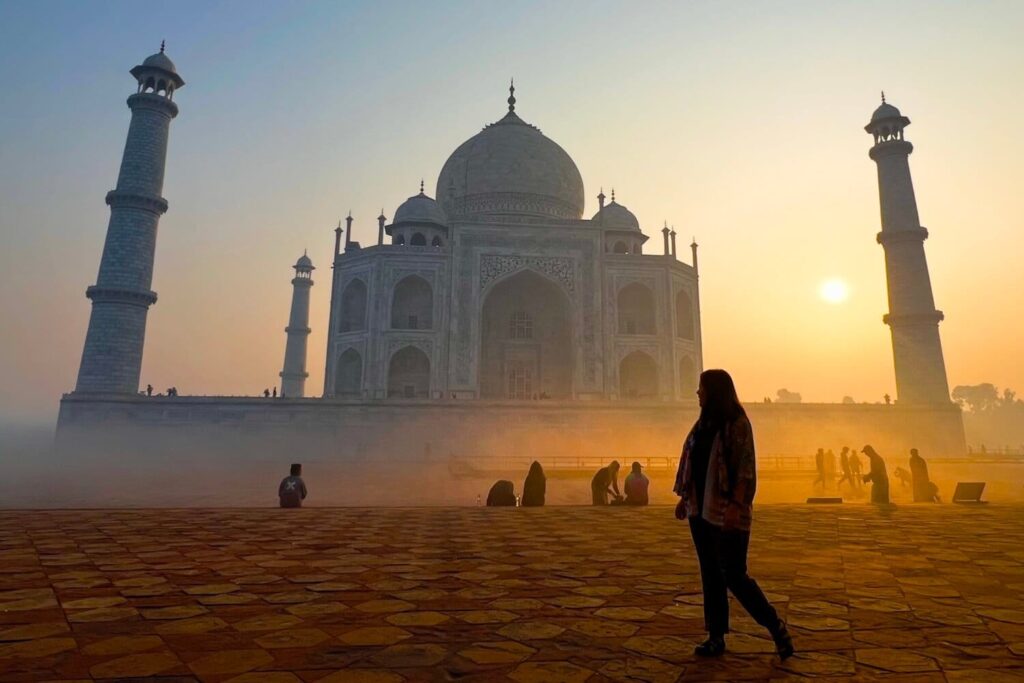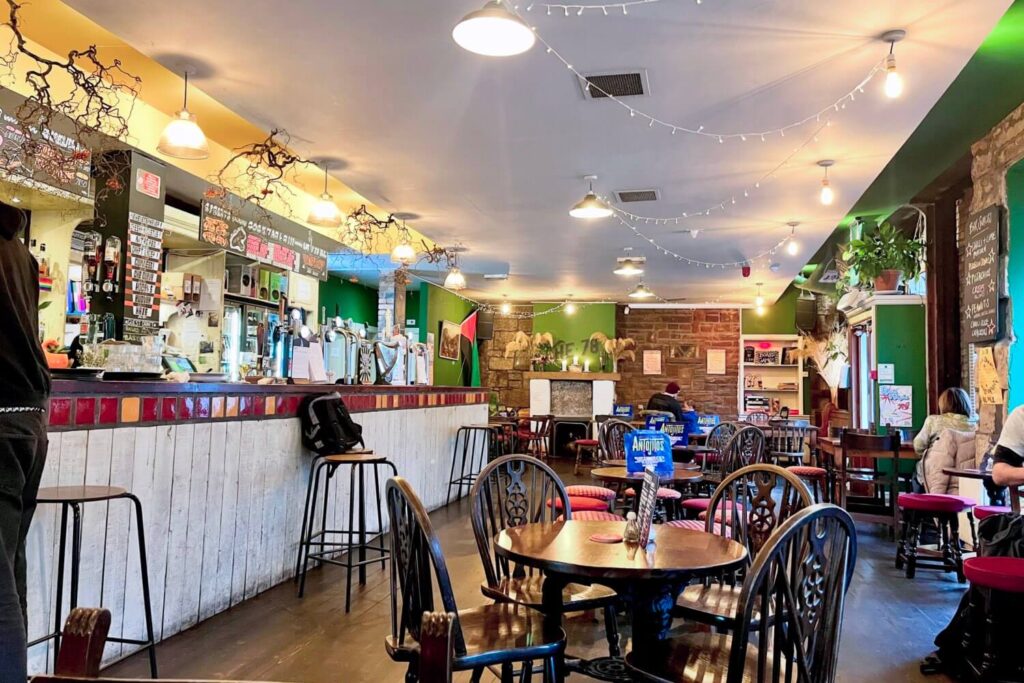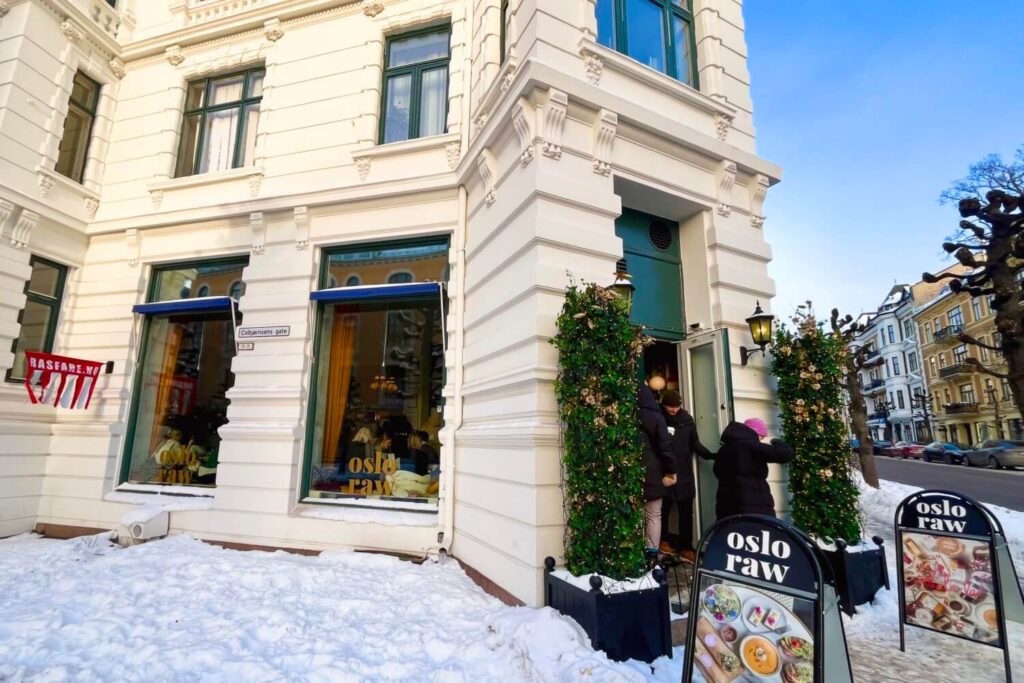In this North India 1 month itinerary, you’ll discover absolutely everything you need to know to plan and book your own adventure in India.
Everything in this travel guide is based on our own month-long trip around India. We’ve included details on the hotels and hostels we stayed in, the activities we booked, the places we visited and the methods of transport we used to get from city to city.
The itinerary is broken down day by day with links provided to our very own mini travel guides, plus links to the accompanying travel vlogs on our YouTube channel.
We really hope you find this North India 1 month itinerary useful. If you have any questions, please do drop them into comments at the bottom of the guide and we’ll do our best to answer them.
Your 1 month North India itinerary starts here
Ready to start planning your 1 month long trip to North India. Here’s the month-long itinerary we followed during our trip.
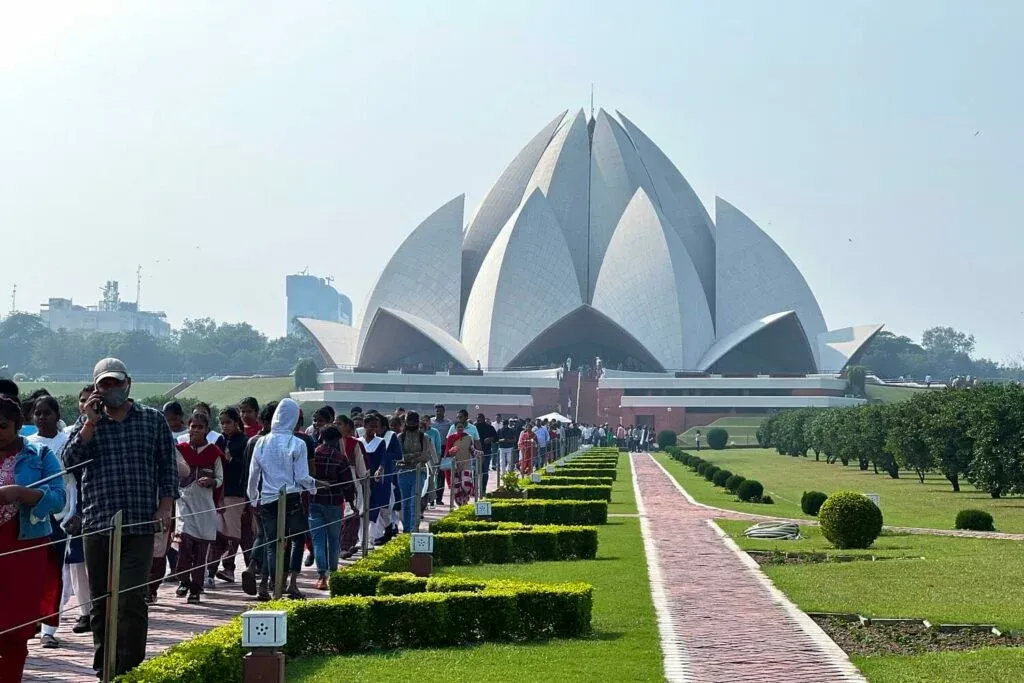
1. Delhi (4 nights)
Stay: We stayed in an Airbnb in Munirka, an urban village in South Delhi.
Our month-long trip to North India began in the country’s capital city, New Delhi. We flew from London Heathrow to Indira Gandhi International Airport with Air India. The flight was fine – the food was great but absolutely nothing worked (i.e. entertainment screen, earphone socket, USB charging socket, call button, reading light – nothing!).
Our flight landed in the morning (local time). We spent the rest of the day sleeping and overcoming the jetlag. That left us with 3 full days to explore Delhi.
Here’s how we spent our three days in Delhi:
Day 1: South Delhi
We explored South Delhi, visiting the Lotus Temple and then Hauz Khas Village, including Hauz Khas Park. We got around using Uber and the Delhi Metro (which is super easy to use).
Day 2: Old Delhi Walking Tour & Lodhi Gardens
We explored Old Delhi on a walking tour run by Street Connections.
Street Connections is a social enterprise, working in tandem with the Salaam Baalak Trust, a charity that provides accommodation, education and training for children living on the street. The walking tour is a great way to see Old Delhi whilst simultaneously ensuring your money goes to a good cause.
The tour starts early, which gave us time in the afternoon to visit Lodhi Gardens, a beautiful public park filled with restored monuments (free entry). Nearby is Lodhi Art District, home to some fabulous street art.
Day 3: Mehrauli Archaeological Park
Mehrauli Archaeological Park is a huge, peaceful oasis filled with the ruins of around 100 monuments and tombs (free entry). Nearby is Qutb Minar, a popular tourist attraction. It was very busy on our visit and we opted to go back to our Airbnb and rest instead, but if you’re feeling up to it, go for it.
Train from Delhi to Amritsar Junction
We travelled in AC Chair class for the 7h5m journey from Delhi to Amritsar. In this class, you get a spacious, reclining chair with plenty of leg room and air conditioning. We booked our tickets using 12Go, which is a service we highly recommend.
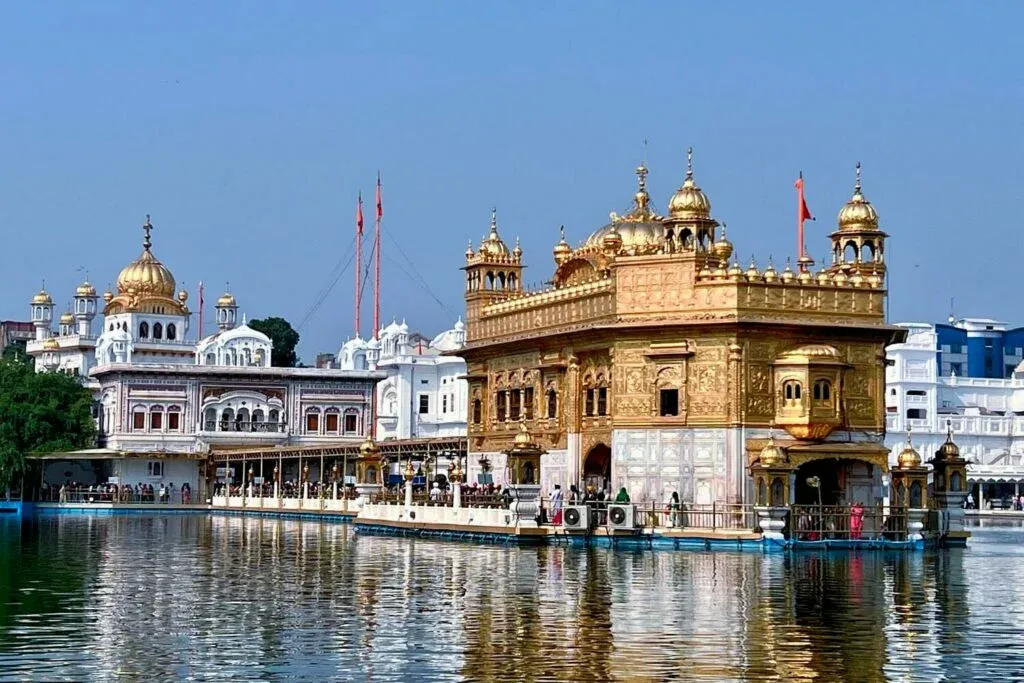
2. Amritsar (2 nights)
Stay: We stayed at FabHotel Aman Residency Sharifpura, which we wouldn’t recommend due to quality issues and staff there posting a fake review on our behalf.
People come to Amritsar for one main reason – The Golden Temple. Even though we only spent 2 nights in Amritsar, we felt this was a sufficient length of time to see all the main sights without feeling rushed.
Our train from Delhi arrived mid-afternoon (referred below as ‘day 1’) which left us enough time to find our accommodation (above) and to visit the Golden Temple that same evening.
Day 1: Golden Temple by night
We heartily recommend visiting the Golden Temple twice during your visit, once by day and once by night. The temple has a very different atmosphere in darkness and daylight, so if you can experience both, that’s a bonus. Entry is free.
Day 2: Golden Temple by day & Border Closure Ceremony
Our first and only full day in Amritsar was a busy one.
We started by paying our respects at Jallianwala Bagh, a park and museum marking the site of a 1919 massacre where anything up to or even exceeding 1500 peaceful protestors were killed by British forces.
The Golden Temple is a short walk from Jallianwala Bagh. Here you can see how appearance of the temple differs in daylight. We then took the opportunity to visit the Langar hall to sample one of the thousands of free vegetarian meals that are served every single day. Everyone is welcome, regardless their background. The process is very strait-forward – simple follow everyone else and replicate what they’re doing.
In the evening, we went to see the Attari-Wagah border closure ceremony. This elaborate and unique ceremony is held every single evening. It’s completely free and not to be missed.
There are a number of ways to get to the ceremony stadium. Auto Rickshaw drivers will usually approach you as you walk around the city to offer their services. If you want to use this option, be sure to haggle as the initial asking price will be very high.
We chose to get there by a Hop On, Hop Off sightseeing bus, which cost us 315 INR each for a return journey. A ticket booth can be found on the Dharam Singh Market Chowk roundabout.
Don’t forget your passport! You’ll need to it to get in. Foreign tourists get great seats right in front of the gates, so keep flashing it as you pass through security and checkpoints to be shown in the right direction.
Bus from Amritsar to Dharamshala
The journey from Amritsar at Dharamshala takes between 4-5 hours and is usually served by good quality ‘Volvo’ buses in a ‘semi-sleeper’ format (large, comfortable reclining seats in a 2+2 layout). You can find some options on 12Go. Travelling by train is not an option for this route.
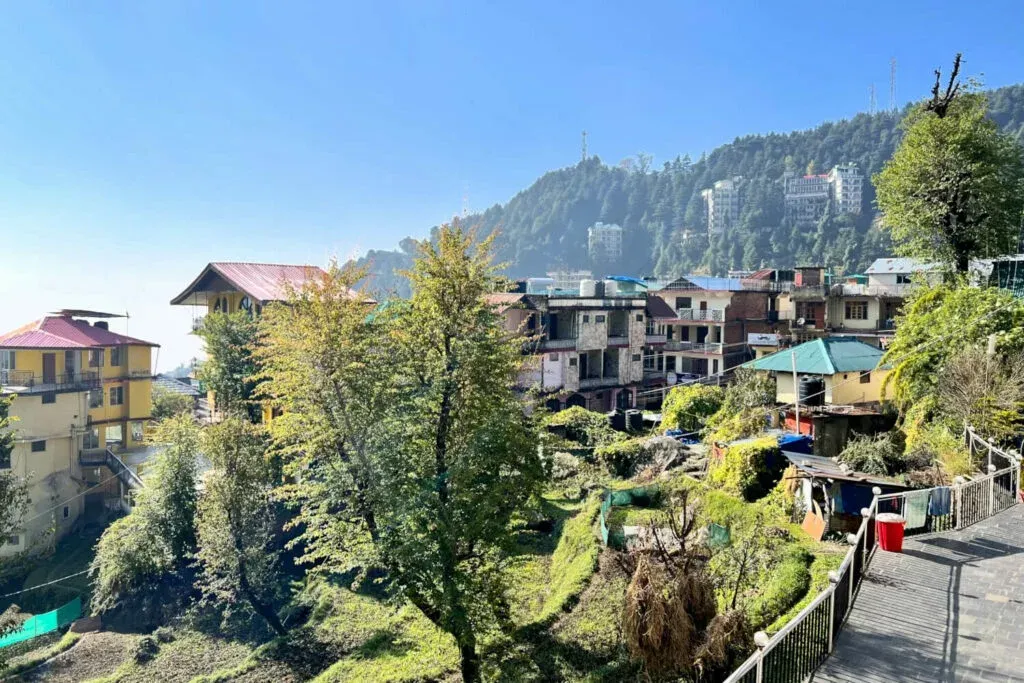
3. Dharamshala (5 nights)
Stay: We stayed at Hotel Sky Pie in Bhagsu, which was clean and comfortable and run by a friendly and helpful team. Note that there is no heating in the rooms, but extra blankets can be requested.
Dharamshala offers visitors an entirely different side of India than what’s on offer in the big cities. Spectacular mountain scenery, lots of fresh & clean air and a noticeable Tibetan cultural influence combine for a truly unforgettable experience.
The journey from Amritsar usually takes the best part of a day. We’ve accounted for this in our itinerary, which begins after the first night. We’ve also included a rest day, which you may be glad of after a week of non-stop adventure.
If you’ve no need for a rest day on the designated day, by all means move days around to suit your needs.
Day 1: Aimlessly wander in Mcleod Ganj/Bhagsu
The villages of Bhagsu and Mcleod Ganj are connected by a road and are a short walk from one another. We spent our first day exploring both on an aimless wander. Browse the shops, stop off at cafes and enjoy the views and the fresh mountain air.
Day 2: Rest Day
Full disclosure, we were both feeling unwell on this particular day, so we’ve designated today a rest day. Other than popping out to get some food from neighbouring cafes/restaurants, we stayed in bed, took some very effective medication and caught up with some TV shows.
Day 3: Bhagsu Falls and Kalachakra Temple
Bhagsu Falls is a popular attraction in Dharamshala. The path to the main falls is well maintained and not too strenuous. The route is lined with small kiosks selling snacks and drinks with some offering seating. We stopped for a cup of tea at a kiosk at the main falls before heading further up the hill to have lunch at Shiva Cafe, a beautiful and popular spot.
Later that day, we headed down the hill again to Mcleod Ganj to enjoy a pre-booked Ayurvedic massage at the Holistic Ayurvedic Massage Centre (which we would recommend). Afterwards, we went to see the beautifully decorated Kalachakra Temple.
Day 4: Dalai Lama Temple
Dharamshala is home to the Dalai Lama in exile and the Namgyal Monastery, often referred to as the Dalai Lama Temple is a must visit. The temple complex is functional above all else and certainly not as colourfully decorated as the Kalachakra Temple in town. Entry is free for all.
Circling the temple complex is the Kora Circuit, a lovely and peaceful walk that is ideally completed in a clockwise direction. The walk mostly passes through woodland and is very nicely decorated with prayer flags. Be wary of the monkeys along the route and look out for the views into the valley as you near the completion of the circuit.
That evening, we headed to Rakus Place for a drink and to enjoy some live music.
Day 5: Teaching English with Monks
Many of the bus services leaving Dharamshala leave at night, so it’s likely your final day will be a long one.
We spent it wandering through the upper pathways of Bhagsu before heading down into Mcleod Ganj to join an English language learning class for monks and Tibetans, run by Learning and Ideas for Tibet. Participation is free and very much appreciated. We spent the hour in guided conversation with a variety of people. It was fascinating!
Overnight Bus from Dharamshala to Rishikesh (via Haridwar)
The 12h30m journey from Dharamshala to Rishikesh is usually served by overnight ‘semi-sleeper’ buses. It’s rare to find a direct service, but the city of Haridwar is around 1 hour to the south of Rishikesh and there are plenty of buses doing the Dharamshala to Hardiwar route.
We travelled with the government-operated Himachal Road Transport Corporation (HRTC) who are more expensive than the private operators but run noticeably nicer and more modern buses. Booking tickets for this route as a foreigner is, for some reason, difficult. We asked our accommodation to book tickets for us.
The drivers (who alternate throughout the journey) were very friendly and made sure to drop us off at the perfect spot where there were waiting Auto Rickshaw drivers to take us the rest of the way.
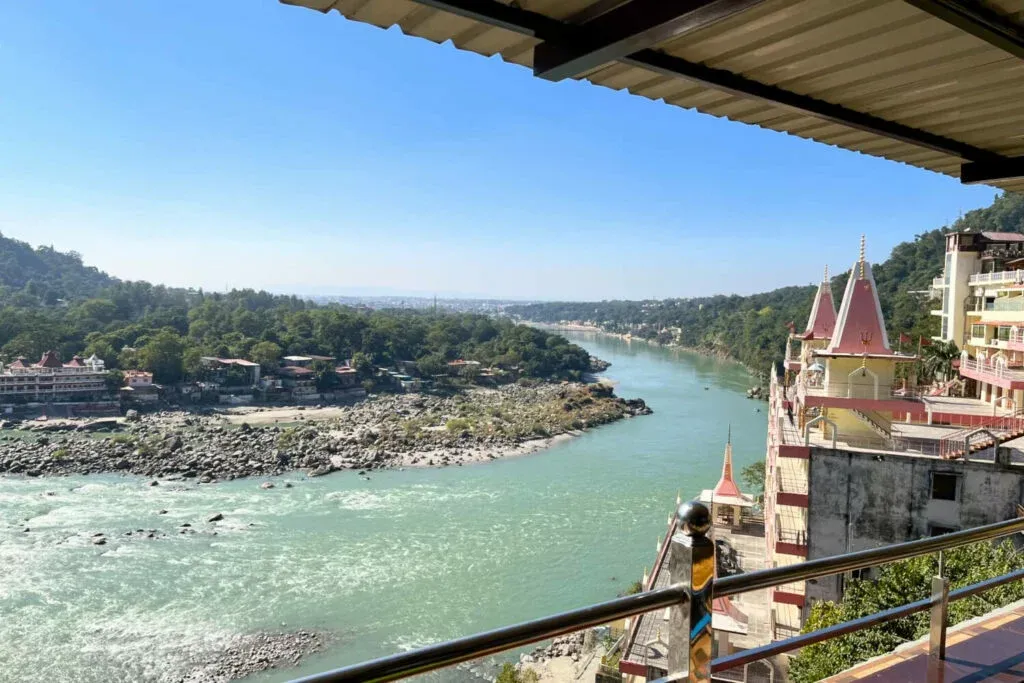
4. Rishikesh (4 nights)
Stay: We stayed in a private double room at Live Free Hostel. The room was really nice and the hostel itself is right in the heart of Tapovan.
Rishikesh is a vibe. Sitting across the banks of the River Ganges, people flock here to enjoy the laid back, hippy atmosphere, the vast array of vegan/veggie food and to learn and practice yoga (Rishikesh being its birthplace).
Not participating in at least one yoga practice whilst in Rishikesh would be a crime. Even if you’ve never done it before, there’s no where better to do so.
We arrived very early into town, so our first day was spent catching up on sleep and chilling in cafes. Our itinerary begins after our first night in Rishikesh.
Day 1: Crossing the Ganges
We spent our first full day in Rishikesh exploring the town mostly on foot, starting in Tapovan where much of Rishikesh’s accommodation is located..
First, we headed to Laxman Jhula, one of three iconic suspension bridges that spans the river. The bridge was undergoing repairs during our visit, so our only option was to take a ferry to hop across. Even if the bridge has reopened during your visit, we still recommend taking the ferry if it’s available. Its cheap and very pleasant.
Once across, we headed south and west along the main road and browsed some of the shops along the way.
Keep following the road closest to the banks of the river, dipping onto the banks itself to soak in the views. Some sections of the river have beaches that you may want to walk along.
Keep walking and you’ll soon reach Parmarth Niketan Ashram. Visitors are welcome to wander about in the gardens and admire the architecture.
Keep heading south and cross Janki Bridge. Once you’ve crossed, head up the main road back to Tapovan. We walked, but we wouldn’t recommend it. Auto Rickshaw’s ply this route, so try to track one down to save yourself an unpleasant uphill walk.
Day 2: Beatles Ashram
Rishikesh is where The Beatles came for spiritual guidance in the late sixties. You can visit the now derelict ashram that they spent time at (known as The Beatles Ashram). To get there, catch a shared Auto Riskshaw from the large bend in the main road to the south west of Tapovan to Janki Bridge and walk the rest of the way.
The ashram is not in the best condition, but the slightly overgrown look and some great artwork combine to create a really interesting experience. There’s a small cafe onsite where you can pick up some tea and noodles.
That evening, we headed to watch an Aarti ceremony at Treveni Ghat (via a shared Auto). This captivating spiritual dedication to the Ganges includes fire, chanting and music. If, like us, you’re lucky enough to get near the front, you’ll be encouraged to take part. Aarti’s take place every day and entry is free.
Day 3: White Water Rafting
The River Ganges (or ‘Ganga’ as it’s known locally) is a critical thread in the tapestry of Rishikesh and in India as a nation. With that being the case, interacting in some way with the holy waters is a must.
One way to do this is by getting in the water itself. I popular way to do this in Rishikesh is White Water Rafting.
There are a number of companies offering white water rafting experiences, with varying prices and ratings. We sought to find a company with a good balance between their review scores, the price and our general impression of the company and its equipment. We chose Red Chilli Adventure.
The experience was excellent, if a little scary in places. The experience started and ended at the company’s office in the centre of town, with transport to and from the river itself. The crew were helpful, friendly and professional and we felt safe throughout.
Overnight Bus from Rishikesh (via Haridwar) to Agra
There are plenty of bus and train services to choose from for this approximately 9h15m route. We travelled with Shri Krishna Travels aboard one of their modern AC sleeper buses. We were really pleased with the private shared cabin we were given. The space was large enough for us to store all of our luggage, had reading lights and AC vents and had a sliding door for privacy. Contrary to our expectations, we ended up sleeping pretty well.
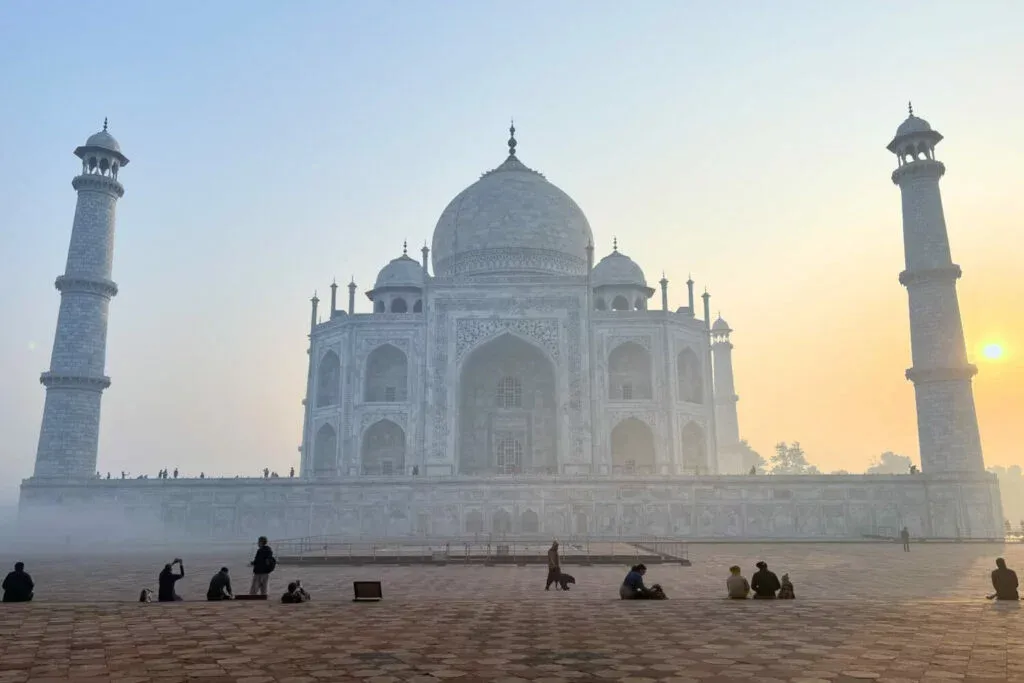
5. Agra (1 night)
Stay: We stayed at Udee’s Homestay which is a short walk away from the Taj Mahal. The room was clean and really comfortable and the family running the place were wonderfully hospitable.
Agra is home to what is perhaps India’s most famous landmark; the Taj Mahal. For most visitors, this is the only reason to visit and we would tend to agree. Apart from a few other minor attractions, there’s not a great deal more to do in the city.
Day 1: Sunset views of the Taj Mahal
After a semi-sleepness night on the sleeper bus, we were grateful that our hotel of choice, Udee’s Guesthouse allowed us into our room early so that we could catch up on some sleep.
After a nap, we headed out for a late lunch to Good Vibes Cafe which we heartily recommend.
Following lunch, our plan was to walk to Taj Nature Walk but on our way there, we were stopped by an auto rickshaw driver who talked into visiting Mehtab Bagh, a park on the other side of the river to get sunset views of the Taj Mahal. Since the quoted price was reasonable, we agreed.
Mehtab Bagh is a little expensive for what it is, but we still had a nice time and the views of the Taj Mahal were lovely.
Day 2: Taj Mahal
The Taj Mahal is best seen as the sun rises. We’re not great with early mornings, but we still managed to walk through the famous entrance gates at around 0730, within an hour of sunrise. Despite not being there precisely on time, the Taj Mahal still looked absolutely gorgeous in the misty early morning light.
We bought our tickets in advance via the official website to speed up the entry process.
How long you spend here is obviously entirely up to you, but as a guide, we spent 2 hours casually strolling around the grounds, taking photos from every conceivable angle.
If you’re interested in learning a bit more about the Taj, there are official guides who will likely offer their services to you. If you’re not interested, politely declining is usually very easy.
Afterwards, we visited Sheroes Cafe, a social enterprise cafe rung by and for the benefit of victims of acid attacks.
Agra is the home of Petha, a popular Indian sweet made from ash gourd (which is usually vegan). Gopal Petha is a great place to pick some up and enjoy a snack at their snack bar.
Overnight Train from Agra Cantonment to Udaipur City
We travelled this 13h10m journey in 3rd AC class aboard the Khajuraho to Udaipur City Express. We were issued with upper bunks close to one another in a modern and noticeably clean carriage. Clean sheets and pillows were given to us as we departed.
Throughout the journey, we felt safe and comfortable and managed to get a little sleep. Our fellow passengers consisted of a mix of people of all ages and genders.
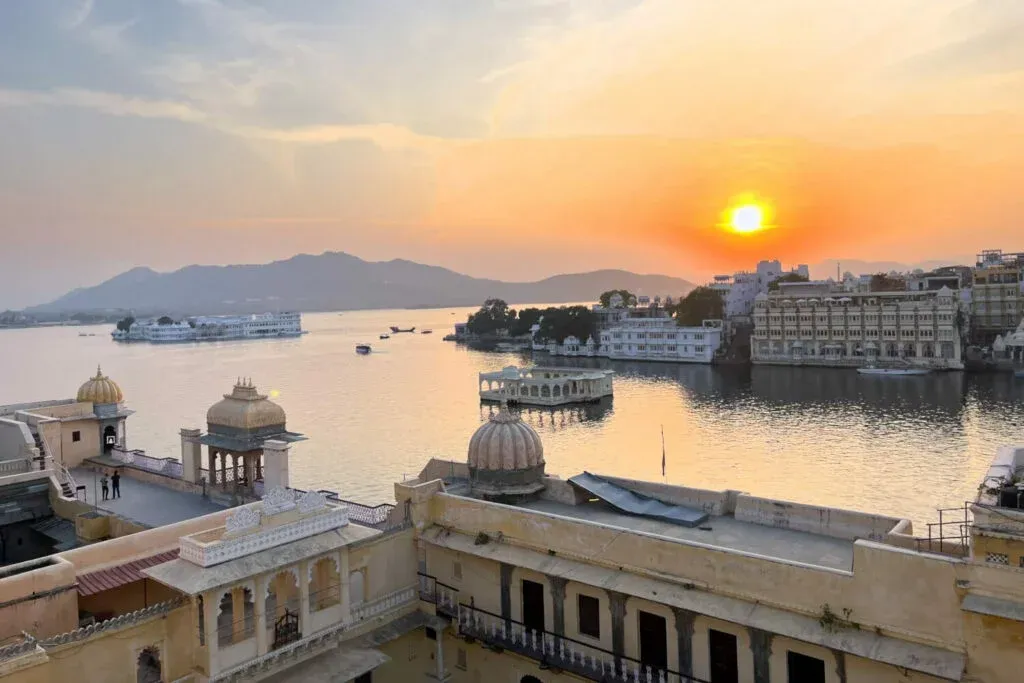
6. Udaipur (2 nights)
Stay: We stayed in a private room at goSTOPS Udaipur. Our room was clean and colourful and staff were very helpful.
Udaipur is known as ‘The White City’ and ‘The City of Lakes’ and once you see the pretty white buildings lining the banks of Lake Pichola, you soon see why.
Udaipur is noticeably clean, very pretty and caters well to tourists, which might go some way to explaining why we really liked our stay there.
There’s a lot to do in Udaipur. Our itinerary starts on the same day that we arrived by train that morning.
Day 1: Bagor Ki Haveli & City Palace
After our early morning arrival, we chilled in the common area of our accommodation for a bit before resting a little in our room.
Lunch was at Yummy Yoga which offers superb vegan food (plus vegan cake) on its rooftop.
Following this, we walked to Bagor Ki Haveli Museum which offers a glimpse at life in a former royal household. The rooms are very pretty and the lakeside location is glorious.
City Palace is a short walk away and as one of Udaipur’s most popular tourist attractions, a must visit. The rooms are in great condition and many are stunning. The palace is very large and can take a couple of hours to explore, so set aside some time to ensure you don’t have rush around.
There are numerous rooftop cafes throughout the city, so if you ever feel thirsty, you’ll have plenty of places to choose from. The views from many of the roofs are incredible.
That evening, we really enjoyed the Lok Dharohar Folk Dance show. Since our visit, the show has moved from Bagor Ki Haveli into a much larger purpose built theatre.
Day 2: Exploring Udaipur
We started our second day in Udaipur with some ayurvedic massages at Ayurveda Ayurvedic Massage Centre which was just across the road from GoSTOPS.
After some tasty toasted wraps at Mavi Vegan Cafe, we walked a short distance to visit the Jagdish Temple, which has been perched atop a tall terrace in the centre of Udaipur since 1651. Entry is free.
Karni Mata Temple at the top of the Machla Magra Hills is around a 30 minute walk from the city centre. As well as the temple itself, there are food and drink outlets where you can sit and enjoy to incredible views over the lake and the nearby mountains. The walk is uphill, but not too strenuous. If you’d prefer, there is a cablecar (called the Mansapurna Karni Mata Ropeway)
Bus from Udaipur to Salawas (via Jodhpur)
We travelled in a non-AC seater bus operated by Kamlesh Travels for this 6h15m journey from Udaipur to Jodhpur. The bus did not turn up on time and we had trouble finding anyone to help us. Thankfully, someone from the operator ended up calling us and we were able to describe where we were waiting. Five minutes later, someone came to find us and lead us to an office and then kept us updated on the bus’ whereabouts.
The bus itself ended up being a sleeper/seater bus. Though we were given seats, many of the passengers had to squeeze themselves into shared bunks.
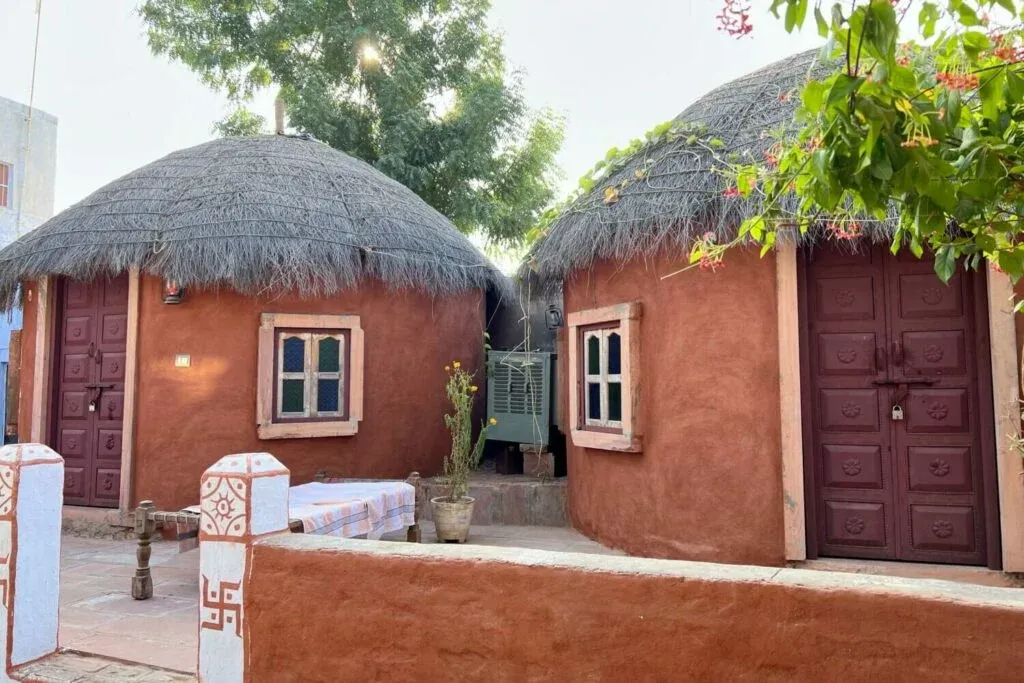
7. Salawas (3 nights)
Stay: We stayed at Chhotaram Prajapat’s Homestay as part of a three night package deal.
Salawas is a small village on the outskirts of Jodhpur and is home to Chhotaram Prajapat’s Homestay, where we stayed as part of a three night package.
In a nutshell, staying at the homestay gives guests a unique insight into village life in Rajasthan.
The accommodation itself comes in the form of comfy and spacious mud huts. The huts all come with private bathrooms and double beds.
Those, like us, who choose a package deal have meals and transfers included, plus a number of activities and excursions.
We really enjoyed the cultural tour of the Bishnoi community and village safari which included an evening walk to the local Hindu temple.
There was also a full day jeep tour of the nearby city of Jodhpur which included visits to Mehrangarh Fort, Jaswant Thada and Umaid Bhagwan Palace.
One of the highlights was the cooking class, where we prepared that evening’s meal with the family, followed by a henna demonstration.
In all, it was an incredible and unforgettable three nights and an experience we would strongly recommend.
Train from Jodhpur Junction to Ajmer Junction (for Pushkar)
We travelled on the Ranikhet Express train for this journey. Since the journey was only 4hr45m, we decided to simultaneously save some money and also experience another different train class by travelling in Sleeper class (despite the entire journey being in the daytime).
This class is non-AC and has open windows for ventilation. By day, middle bunks are folded up so that passengers can sit on the lower bunks. The train we were on was practically empty for our journey, so we had plenty of room. The train interior was quite dusty and ageing, but it was comfortable enough.
Upon arrival in Ajmer, we were reliably approached by auto rickshaw drivers who all knew we were heading to Pushkar.
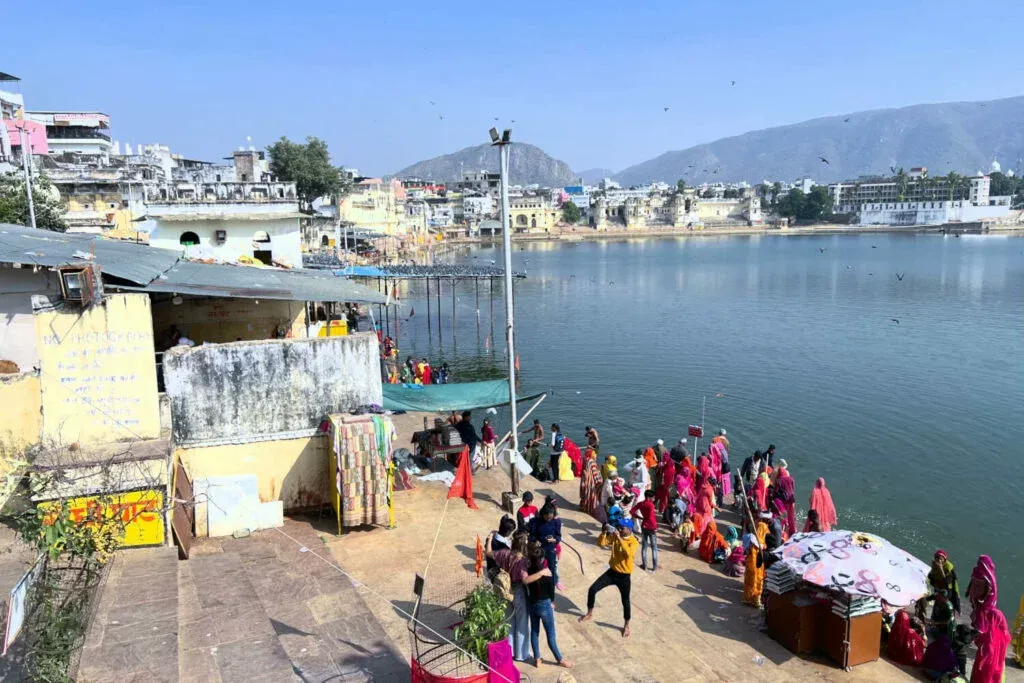
8. Pushkar (2 nights)
Stay: We stayed at Kanhaia Haveli, which is a couple of blocks from Pushkar Lake. The haveli is very decorative and staff were keen to impress.
The town of Pushkar is a sacred pilgrimage site for both Hindus and Sikhs. At its heart is Pushkar Lake, whose shores are lined with evocative temples and ghats.
Pushkar’s main draw for tourists is simply being there and absorbing the sights and sounds. We’re only spending two nights here. Our itinerary is pretty simple (it’s just the full day between the two nights) and allows you to go at your own pace.
Day 1: Ghats of Pushkar Lake
Pushkar Lake is pretty small and can be circumnavigated on foot in a comfortable hour. We strolled around at a leisurely pace, stopping often to observe and take photos. The entire boundary of the lake is lined with temples and ghats, some prettier than others, some playing music, some busy, some not.
It’s worth noting that shoes must not be worn at the lakeside, so you may wish to bring a bag with you to carry them. Additionally, discretion may be required at times in order to maintain the dignity and serenity of worshippers.
Nearby are shops, market stalls and a plethora of vegetarian/vegan eateries (Pushkar being an entirely vegetarian town).
Train from Ajmer Junction to Jaipur
There are a lot of train services between Ajmer and Jaipur, so you shouldn’t have too much trouble finding seats. We travelled to 2h12m journey in Second Sitting class. The coach was certainly showing signs of age and the seating layout of 3+3 was maybe a little cramped, but the seats themselves were comfortable enough for such a short journey.
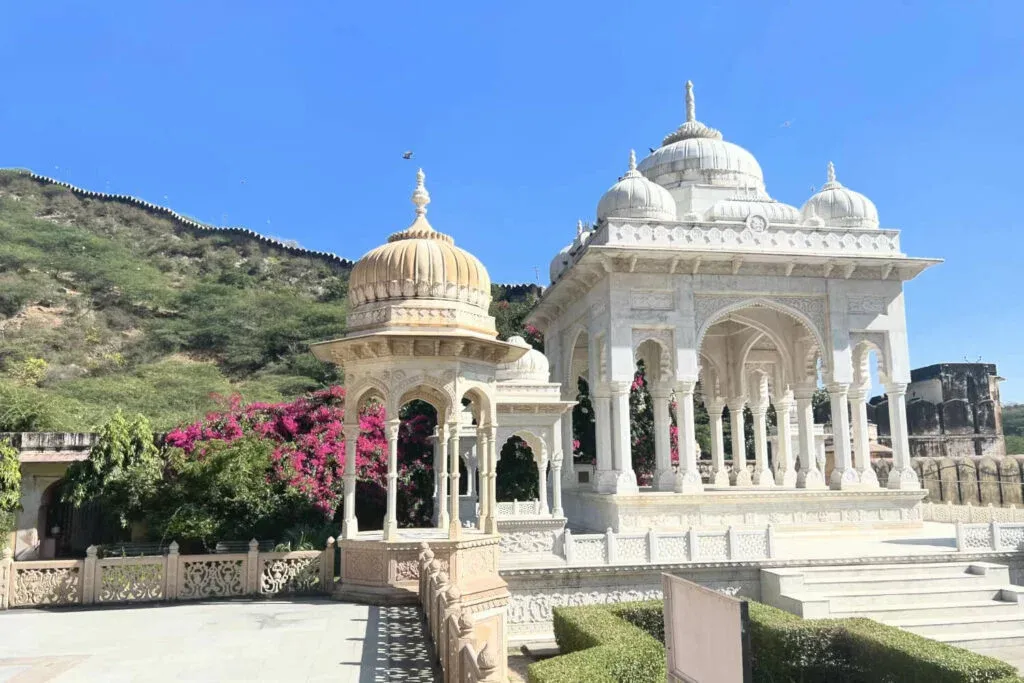
9. Jaipur (2 nights)
Stay: We stayed in a clean and comfortable private room at goSTOPS Jaipur.
Jaipur is known as ‘The Pink City’ (or at least part of it is) and forms one corner of India’s famous Golden Triangle tourism route.
It’s quite possible to see most of the city’s main sights in one day. Indeed, it’s quite likely you’ll be offered a day tour upon your arrival at the train station by your taxi or auto rickshaw driver.
Prices can vary considerably, so think of a budget before you start talking and stick to it. If necessary, some friendly bartering is somewhat expected. Sometimes, drivers will be reluctant to even set a price and will suggest that you just pay what you think. This is a clever money earning tactic. We always made sure a price was agreed before services were provided throughout our time in India, with additional tips given whenever we felt is was due.
We spent our arrival day in Jaipur settling into our accommodation and finding somewhere to eat. The next day, we were out to see what the city had to offer.
Day 1: Auto Tour of the Pink City
We paid 1200 INR for a full day tour of Jaipur with Ali, a friendly auto rickshaw driver who picked us up from the train station. He set the initial price and we thought it was such good value that we saw no need to barter him down.
The tour took in all the main sights, including the City Palace, Janta Manta observatory, Hawa Mahal, Gaitor Ki Chhatriyan, Panna Meena Ka Kund step well, the iconic Amber Palace and Jal Mahal.
We were offered visits to some shops (of which, Ali would have likely have taken a commission). We largely declined as we didn’t want to buy anything, though we did agree to visit a block printing workshop (where there was no hard sell).
As you might expect, entrance fees to each of the attractions were not included in Ali’s fee and were payable separately. The entire tour fit comfortably in a day and didn’t feel at all rushed.
We started the day at around 10am and finished around 6pm.
Train from Jaipur to Delhi
The final leg of our tour of north India was the 6h30m journey from Jaipur to Delhi. We were curious to see what Second AC class was like, so we spent a little extra to find out. Second AC is a sleeper class, but during our daytime journey, most passengers sat on the lower bunks. The journey itself was very pleasant and spacious. Our fellow passengers were very friendly and helped us to arrange a connection to our hostel which cut our journey time by around an hour.
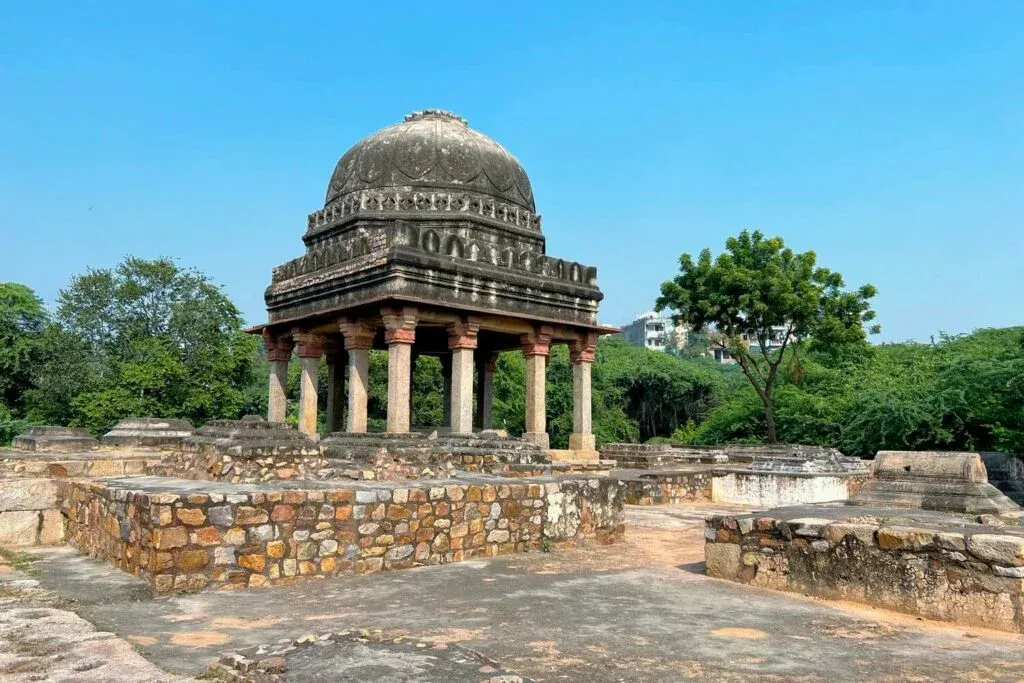
10. Delhi (1 night)
Stay: We stayed in a private double room at Hide-In Hostel. The room was huge and the bed was very comfortable. Staff didn’t speak English and checking-in was mysteriously problematic. Our private bathroom didn’t smell so good. Overall, it was fine for one night.
We completed our month-long loop of northern India where we started it, back at the nation’s capital, New Delhi.
With a flight to our next destination the next morning, we chose not to do too much with the few hours we had. It had been a while since we had seen a modern shopping mall, so we chose to spend the evening at Nexus Select CityWalk mall, we we enjoyed a delicious vegan meal at Burma Burma restaurant.
The next morning, we used Uber to grab an Auto Rickshaw to the airport.
